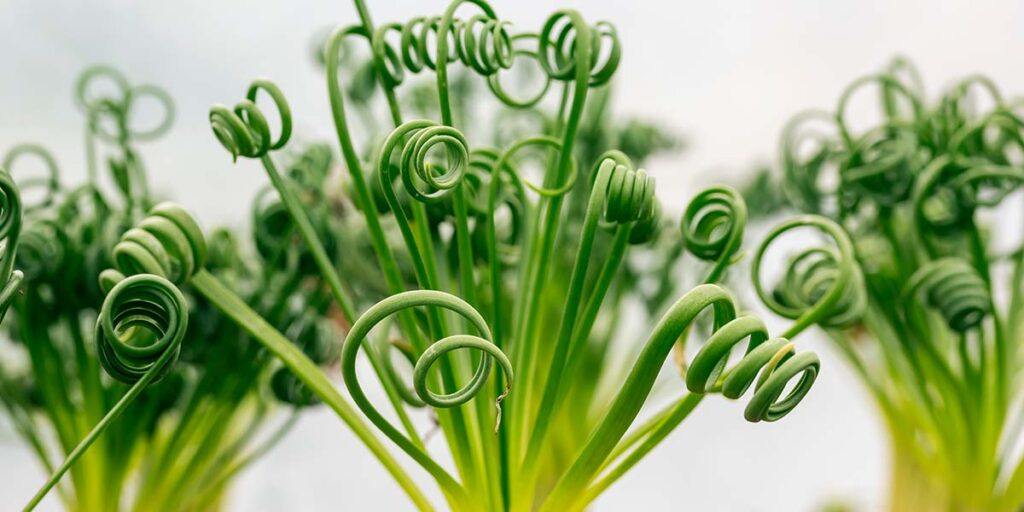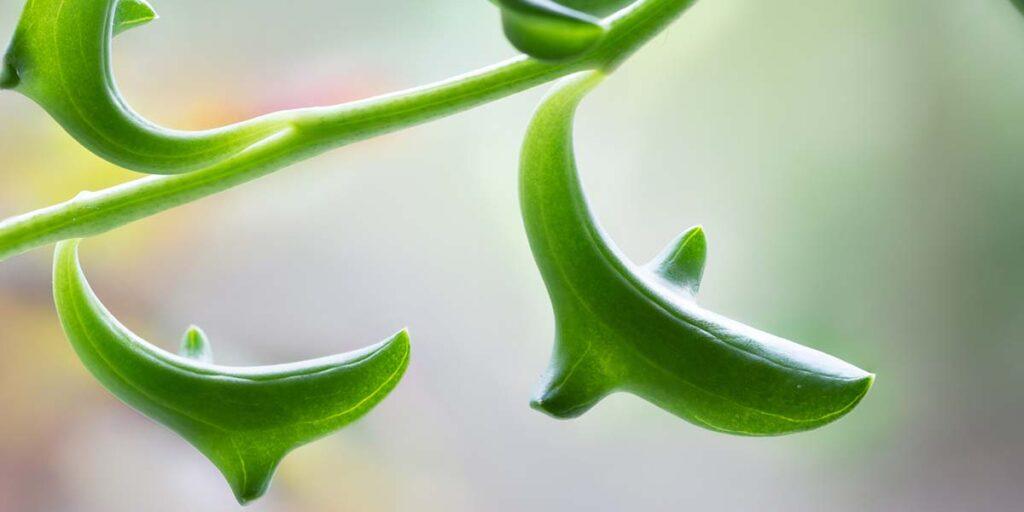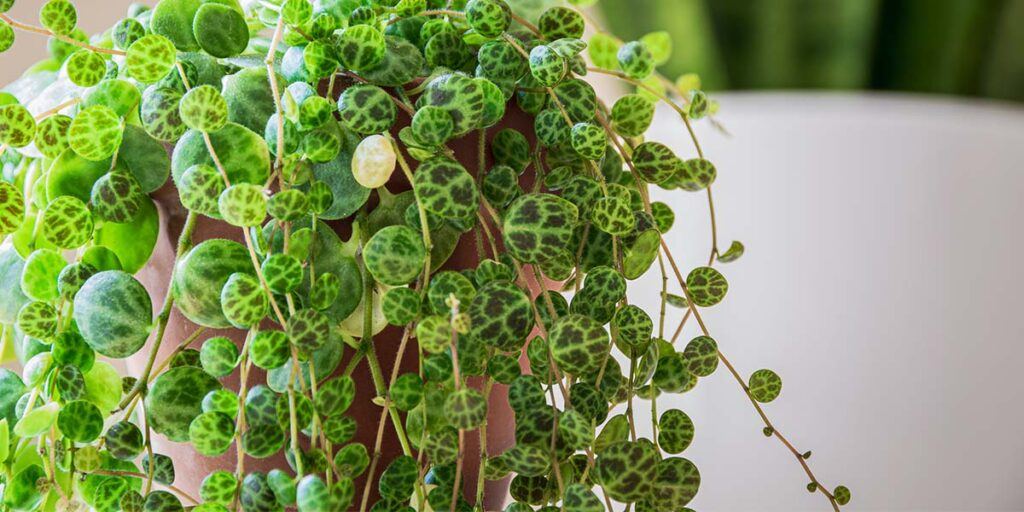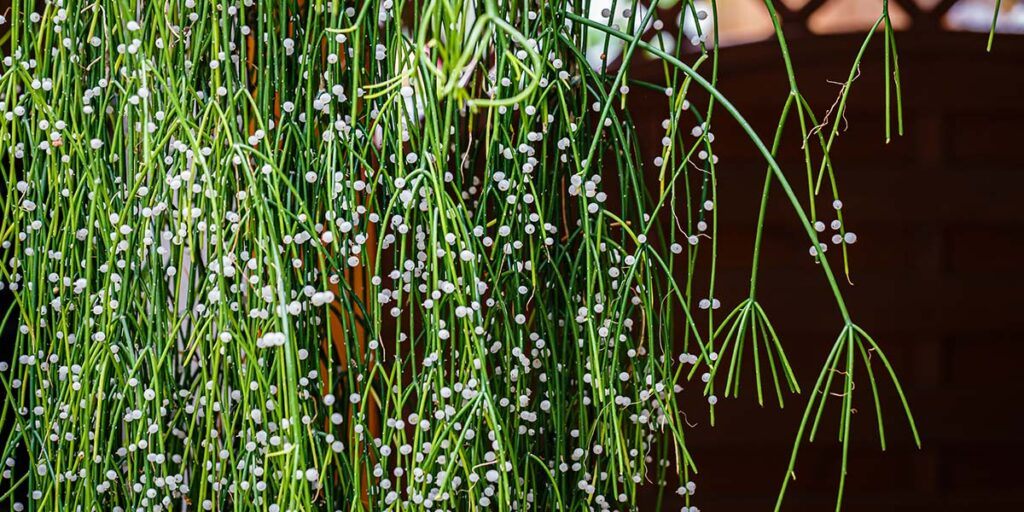
By Angelo Randaci, Earth’s Ally Horticulturist
Angelo’s passion for plants has led him to explore many areas of horticulture including research, grounds management, technical training, design and nursery management.
Interesting Succulents for Your Garden
There are many oddities that exist within the world of succulents. Thanks to the efforts of plant purveyors, collectors and hybridizers we can now enjoy several unusual offerings. The following is a list of six types of succulents that emphasize strange shapes and growing habits. Both kids and adults alike will enjoy the visual interest these succulent plants bring to a garden. While many succulents favor full sun conditions, these plants prefer lower light conditions and will thrive with bright indirect light.

#1 Corkscrew Albuca (Albuca spiralis)
Corkscrew albuca is a succulent from South Africa that grows from a bulb. It is known for its long, narrow dark green leaves that grow into a corkscrew pattern. Yellow-greenish vanilla scented flowers emerge during periods of active growth. Unlike other plants that rest in the winter, this one goes through a dormancy period during summer months and resumes growth in winter when temperatures begin to cool. Because the plant is dormant during the summer months, water should be held to a minimum at that time, once every 2 or 3 weeks or when the soil is completely dry. During winter, when the plant is in active growth, adjust your watering to once a week or just enough to keep the soil evenly moist but not soggy. Plant in a clay pot with your favorite succulent soil mix and give it a bright light. This plant is not bothered by pests or diseases, but overwatering can cause root rot. Albucas are toxic to pets if ingested and may cause mild oral and gastrointestinal upsets.

#2 Sweetheart Hoya Plant (Hoya kerrii)
Sweetheart hoya is appropriately named for its stunning heart-shaped leaves. This tropical succulent vine from Southeast Asia is often sold with a single leaf planted upright in a small pot. The single leaf will probably not grow into a vine but will remain a single leaf until it eventually dies. Purchase a plant with multiple leaves instead to grow it into a hanging basket. This plant makes an excellent Valentine’s Day gift for anyone wishing to shy away from traditional roses or chocolates. For best growth, place your hoya plant in an area with bright, indirect light and allow the soil to dry out between watering, but not so dry that the leaves wrinkle. The beautiful, star-shaped white flowers with burgundy centers may appear after a few years of growth. Yellow leaves and root rot are a common problem from over watering. Pests include mealybugs, aphids, and spider mites. Hoyas are non-toxic to children and pets.

#3 Starfish Sansevieria (Sansevieria cylindrica ‘Boncel’)
While you may be familiar with the common snake plant or mother-in-law’s tongue, Starfish Sansevieria ‘Boncel’ is a different species grown for its unusual cylindrical leaves. This particular hybrid of Sansevieria cylindrica has all the attributes of the common snake plant; easy to grow, tolerant of sun or shade (bright light is best) and like other succulents will thrive with very little water. Grow this plant in a succulent potting mix and keep watering to a minimum, about once or twice a month, even less during winter. Sansevierias are basically trouble free although overwatering can cause root rot and fungal infections. Pests include mealybugs and spider mites. Sansevierias are toxic to dogs and cats.

#4 String of Dolphins (Senecio peregrinus)
String of Dolphins is a delightful trailing succulent with chalky blue leaves that resemble tiny leaping dolphins. The trailing branches up to 3 feet long are very attractive either in a hanging basket or mixed container along with other succulents. Grow this plant in in indirect light. Avoid direct sun. It is tolerant of artificial light and is suitable to growing in an office situation. Grow in a succulent potting mix and water sparingly, allowing the soil to dry before watering. String of Dolphins is toxic to pets and small children.

#5 String of Turtles (Peperomia prostrata)
String of Turtles is an unusual easy to grow succulent. The leaves are shaped like the shells of miniature turtles strung together on a tiny trailing vine. It thrives in the conditions of the average home making it an excellent house plant choice. Avoid growing String of Turtles in full sun, but rather place them in an area receiving bright indirect sunlight. A standard potting mix rich in peat is ideal. Keep this plant slightly moist during the growing season but allow the soil to dry before watering during winter months.

#6 Mistletoe Cactus (Rhipsalis baccifera)
Mistletoe Cactus is an epiphytic cactus with long thread-like light green pendent stems. This is another excellent choice for a hanging basket. Greenish white blooms are followed by white fruits that resemble the berries on mistletoe. Mistletoe cactus makes an ideal choice for easy-care hanging planters. It will thrive in bright indirect sunlight but will tolerate lower light conditions. The best potting mix is slightly acidic and well drained. A homemade mix consisting of two parts peat moss, one part sand and one part fine-grade fir bark will grow a healthy plant. Unlike other succulents on this list, Mistletoe cactus requires water regularly during the growing season, but reduced water during winter months. This plant is not bothered by serious pest or disease problems although overwatering may cause root rot. It is also safe for children and pets and the fruits are even edible.
How to Care for Succulents
- Watering Succulents: Proper watering will ensure your plants stay vibrant and healthy. Succulents hold moisture in their fleshy stems, roots, and leaves. Because of this, they can survive long periods of drought conditions. Over watering is the most common problem that occurs with succulents. To avoid this problem, try the Drench and Dry Method. Begin with completely dry soil, then saturate the soil with water until you see it leaking out the drainage holes. Saturate again to be sure you completely wetted the soil. Do not water again until the soil is completely dry. Remember to reduce watering when your plant is not actively growing.
- Drainage: Make sure your containers have adequate drainage. Because tiny drainage holes can clog easily, choose succulent pots with plenty of large drainage holes. Put a piece of broken pot or other material over the drainage hole to prevent soil from falling out the bottom. Unglazed clay pots provide a healthy environment for your succulents. Because the clay is porous, air and moisture can enter through the sides of the pot. Clay pots will also act like a wick to remove excess moisture from your potting mix.
- Pests and Disease: Most problems associated with succulents are diseases from overwatering. However, they do get the occasional insect pest like spider mites, scale and mealy bugs. To treat soft-bodied insects, Earth’s Ally Insect Control is highly effective and safe for people, pets and the planet.
- Light: Plants on this list will thrive in bright light conditions. Full sun can cause leaves to burn and even kill your plant. Plants that lean toward your light source will benefit from rotating the containers a quarter turn every few days. Stretching may also be a sign that your plants need a brighter spot. If you don’t have adequate light in your home, consider growing your plants under artificial lights.
- Soil and Fertilizer: Use a quality succulent potting mix for all your succulents. If you mix your own, you can use two parts sand, two parts potting mix and one part perlite. Most succulents will grow well with a fertilizer formulated for succulents. Only fertilize your plants during periods of active growth. Be sure to read plant care information given on the label. For some succulents, half strength fertilizer is all that is needed. Less is better than more.
Do a little research on the succulents you wish to purchase before you buy. This way, you can either choose plants that will do well in your conditions, or you can modify your environment to suit the needs of the plant.
We’d love to hear how Earth’s Ally is helping you grow healthy succulents. Share your experience and stay connected with the #EarthsAlly community on Facebook, Instagram and Twitter for access to our latest blog posts, giveaways and exclusive promotions.
